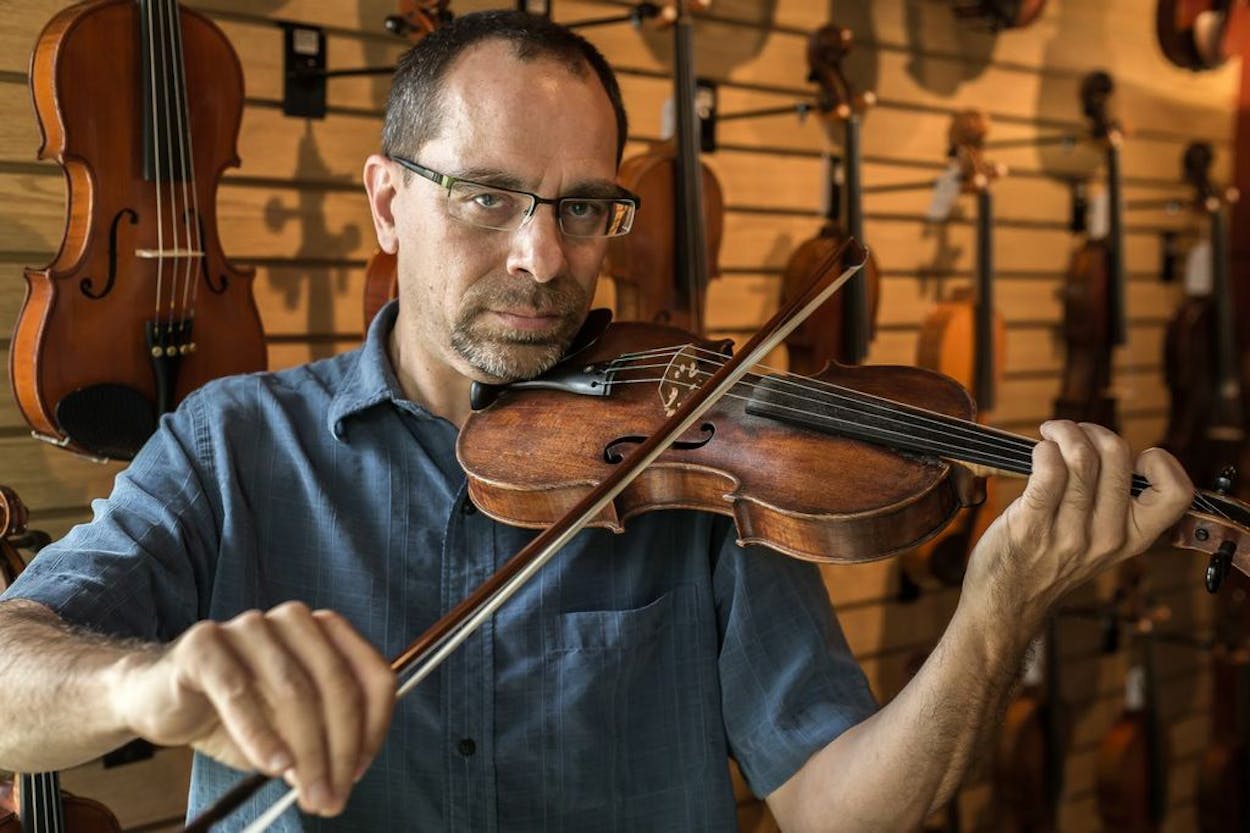During the mid-nineteenth and early twentieth centuries, a distinctive form of fiddle music emerged in Texas. Known for idiosyncratic timing and phrasing, this style was commonly played with banjos or guitars on front porches or in living rooms, less for show and more for social interaction. It reflected the cross-pollination in Texas following the Civil War, with touches of African-American, Appalachian, Cajun, Czech, German, Irish, Mexican, Polish, and Scottish musical forms.
“And then it just evaporated,” said Howard Rains, an Austin musician and one of the few people in the state who performs this nearly extinct genre of fiddling. “It was just gone. Everything changed after the Depression.”
The 43-year-old musician has established himself as an authority on old Texas-style fiddling with his recently released album, The Old Texas Fiddle, dedicated to preserving this hand-me-down music, which was not commonly recorded or committed to sheet music.
Western swing and contest-style fiddling all but buried old Texas fiddle music. In the thirties, the Texas bandleader Bob Wills took the fiddle out of its folk environs—the cotton fields near Kosse, where he grew up—and into dance halls and onto the radio. Bob Wills and His Texas Playboys, a large band with multiple fiddles, played western swing, a mix of country and jazz that raised spirits dampened by the Great Depression.
Meanwhile, Texas contest-style fiddling was undergoing an overhaul. In the late twenties, Benny Thomasson, an acclaimed old Texas fiddler from near Gatesville, suffered a tough loss in his very first contest.
He went back to the woodshed and reworked older melodies into arrangements that required a virtuoso’s skills to play, then went on to win fifteen state championships, evolving contest-style fiddling into today’s improvisational game of packing as many notes into a space as possible. Rains calls it “fiddling on steroids.”
“It’s the greatest fiddling ever known to man,” Rains said. “Or it’s this horrible aberration that’s overrun the old styles.”
Rains, a sixth-generation Texan who grew up in Sherman but calls Marshall his family’s “cultural home,” began playing violin in elementary school.
“In orchestra, I was always last chair,” he said with a laugh.
He was around thirty years old when he inherited a set of fiddles, including a 250-year-old German one and a 100-year-old one built for his grandfather by the Dallas-based violin maker F.A. Sennett. They had been played by men in his family going back to his great-grandfather, the former director of the North Texas Hospital for the Insane.
Rains started with common fiddle tunes like “Soldier’s Joy” and “Cripple Creek” but soon gravitated to older, more obscure songs. He began adding his own flourishes, creating the interpretations on his album.
He learned “Goodbye My Little Darlin’,” as played by Lewis H. Propps of Pleasanton, from a recording by Mike Seeger, the half-brother of Pete Seeger. Rains drew on his roots in East Texas and southern Louisiana, peppering the song with a Cajun vibe. He added a second fiddler, emphasized the first beat, and used a strict down-up bowing pattern common in Cajun waltzes.
He went directly to the source for “Nacogdoches Waltz” and “Mowing the Meadow,” a variation of the Appalachian standard “Sugar in the Gourd.” Stafford Harris from Nacogdoches, one of the last of the old-time Texas fiddlers, taught them to Rains before his death in 2010.
“No one’s done this research because nobody cared, because you couldn’t win a contest and you couldn’t turn a buck,” said Mark Rubin, the former bassist for the Austin band the Bad Livers, who steered Rains away from Appalachian music and back toward his Texas heritage. “The fact that there’s even a single person in Texas who wants to peel back that narrative and join with the holistic way of making music is incredibly admirable.”
The album’s standout track is “Peep O’Day,” a dance number known to only a few. It’s one of six songs on the album by Duck Wootan of Junction (whose real first name was Thomas Jefferson). They made their way to his grandson Tim Wooten, who knows Rains through the Austin Friends of Traditional Music. This highly unusual tune uses a wide range of notes and is “crooked”; it has an uneven number of beats per measure in the first and second parts of the tune, causing them to fold into one another almost indistinctly.
“Howard probably has worked harder and longer to perfect his fiddle technique than anybody I know,” Wooten said. “He’s very fluid and polished.”
The album even has popular contest-style tunes like “Tom & Jerry” and “Grey Eagle.” But they’re arranged in a bygone way that may stump contest-style fiddlers. This goes to show that no one really knows where many of these fiddle tunes originated—or where they’re going, maybe when Rains’s son, Isaiah, who plays fiddle on “Put Your Little Foot,” comes into his own.
“I don’t pretend to be presenting museum pieces,” said Rains, also an accomplished painter. “I internalize this music and make it my own. I obsessively listen to these old fiddlers, so I think I have the right to do what I want with it.”






